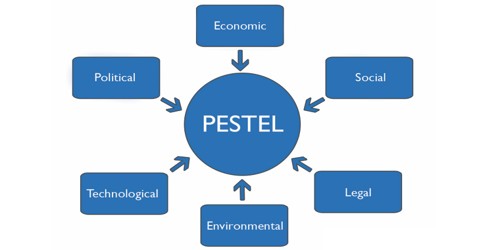The environment of an organization consists of it surrounding anything that affects its operation favorably or unfavorably. Organizations environment includes those factors (internal and external) that affect the operations of the business directly or indirectly.
Six most commonly assessed factors in the environmental analysis –
(1) “P” FOR POLITICAL FACTORS: The political factors take the country’s current political situation. It also reads the global political condition’s effect on the country and business. When conducting this step, ask questions like “What kind of government leadership is impacting the decisions of the firm?”
Some political factors that you can study are:
- Government policies,
- Taxes laws and tariff,
- Stability of government,
- Entry mode regulations.
(2) “E” FOR ECONOMIC FACTORS: Economic factors involve all the determinants of the economy and its state. These are factors that can conclude the direction in which the economy might move. So, businesses analyze this factor based on the environment. It helps to set up strategies in line with changes. I have listed some determinants you can assess to know how economic factors are affecting your business below:
- The inflation rate,
- The interest rate,
- Disposable income of buyers,
- Credit accessibility,
- Unemployment rates,
- The monetary or fiscal policies,
- The foreign exchange rate.
(3) “S” FOR SOCIAL FACTORS: Countries vary from each other. Every country has a distinctive mindset. These attitudes have an impact on the businesses. The social factors might ultimately affect the sales of products and services. Some of the social factors you should study are:
- The cultural implications,
- The gender and connected demographics,
- The social lifestyles,
- The domestic structures,
- Educational levels,
- Distribution of Wealth.
(4) “T” FOR ‘TECHNOLOGICAL FACTORS: Technology is advancing continuously. The advancement is greatly influencing busin6ses. Performing environmental analysis on these factors will help you stay up to date with the changes. Technology alters every minute. This is why companies must stay connected all the time. Finns should integrate when needed. Technological factors will help you know how the consumers react to various trends. Firms can use these factors for their benefit:
- New discoveries,
- Rate of technological obsolescence,
- Rate of technological advances.
(5) “L” FOR LEGAL FACTORS: Legislative changes take place from time to time. Many of these changes affect the business environment. If a regulatory body sets up a regulation for industries, for example that law would impact industries and business in that economy. So, businesses should also analyze the legal developments in respective environments. I have mentioned some legal factors you need to be aware of:
- Product regulations,
- Employment regulations,
- Competitive regulations,
- Patent infringements,
- Health and safety regulations.
(6) “E” FOR ENVIRONMENTAL FACTORS: The location influences business trades. Changes in climatic changes can affect the trade. The consumer reactions to particular offering can also be an issue. This most often affects agri-businesses. Some environmental factors you can study are:
- Geographical location,
- The climate and weather,
- Waste disposal laws,
- Energy consumption regulation,
- People’s attitude towards the environment.
There are many external factors other than the ones mentioned above. None of these factors are independent. They rely on each other. If you are wondering how you can conduct an environmental analysis, here are 5 simple steps you could follow:
- Understand all the environmental factors before moving to the next step.
- Collect all the relevant information.
- Identify the opportunities for your organization.
- Recognize the threats your company faces.
- The final step is to take action.
It is true that industry factors have an impact on the company performance. Environmental analysis is essential to determine what role certain factors play in your business. PEST or PESTLE analysis allows businesses to take a look at the external factors. Many organizations use these tools to project the growth of their company effectively.














